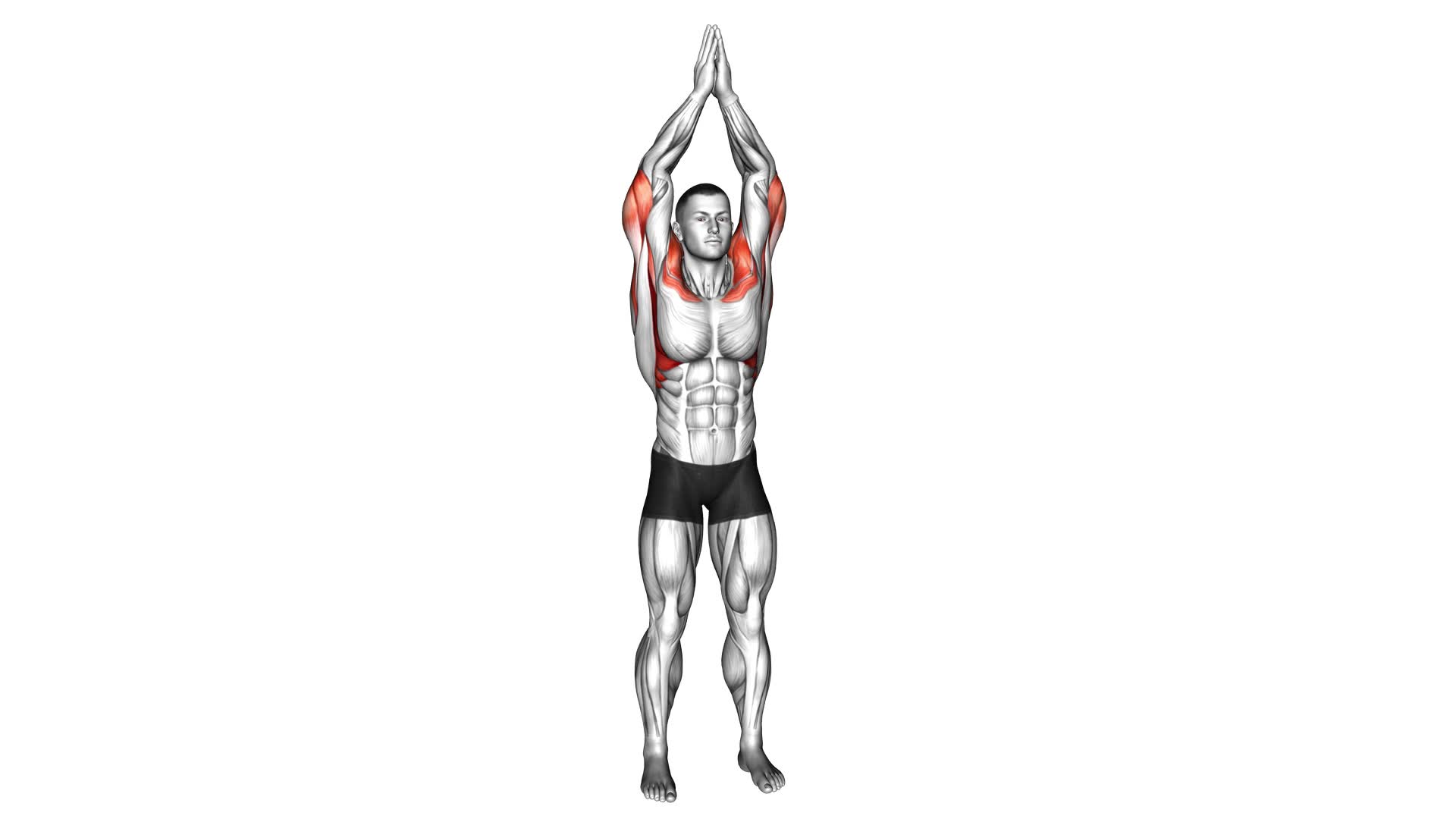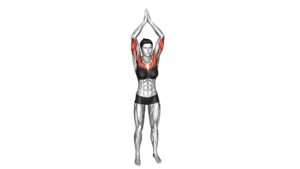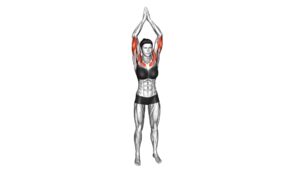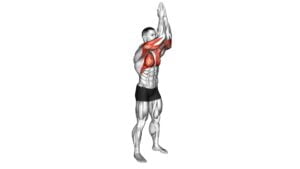Prayer Push – Video Exercise Guide & Tips

Are you looking for a new exercise to add to your routine? Look no further than the prayer push!
Watch This Exercise Video
This video exercise guide and tips will show you how to properly perform this exercise, with modifications for different fitness levels.
Learn the benefits of the prayer push, the equipment you'll need, and common mistakes to avoid.
Get ready to incorporate the prayer push into your workout routine for a full-body burn!
Key Takeaways
- The prayer push engages multiple muscle groups and improves balance and stability.
- It tones and strengthens targeted areas while reducing stress and promoting relaxation.
- Proper form and technique include maintaining a straight back, keeping elbows close to the body, and avoiding strain on the lower back.
- Modifications for different fitness levels include performing on knees, using support from a wall or elevated surface, and incorporating equipment like dumbbells or resistance bands.
Benefits of the Prayer Push
The Prayer Push offers numerous benefits for your physical and mental well-being. This exercise is a great way to improve your overall fitness and mental clarity.
In terms of physical benefits, the Prayer Push engages multiple muscle groups, including your arms, shoulders, chest, and core. By pushing your hands together in a prayer position and then extending your arms forward, you're effectively toning and strengthening these areas. Additionally, this exercise helps to improve your balance and stability, as you have to maintain a steady posture throughout the movement.
In addition to the physical benefits, the Prayer Push also provides several mental benefits. As you perform this exercise, you're required to focus on your breath and concentrate on the movement of your body. This mindful approach can help reduce stress and anxiety, promoting a sense of calm and relaxation. Moreover, the repetitive nature of the Prayer Push can serve as a form of meditation, allowing you to quiet your mind and find inner peace.
Proper Form and Technique
To perform the Prayer Push exercise with proper form and technique, you should begin by standing with your feet hip-width apart. This position provides stability and balance throughout the movement.
Many people make common mistakes while exercising, such as using incorrect form or sacrificing technique for quantity. However, it's crucial to understand the importance of proper form in workouts.
Maintaining proper form during exercises ensures that you're targeting the correct muscles and maximizing the effectiveness of your workout. When you perform the Prayer Push, it's essential to engage your core muscles, keep your back straight, and avoid arching or rounding your spine. By doing so, you protect your spine and prevent unnecessary strain on your lower back.
Another common mistake is allowing your elbows to flare out to the sides during the push-up motion. To avoid this, keep your elbows close to your body, forming a 45-degree angle. This position not only reduces the risk of shoulder injuries but also helps to engage your chest and triceps more effectively.
Modifications for Different Fitness Levels
When modifying the Prayer Push for different fitness levels, consider the intensity and resistance that best suits your abilities. For beginners, it's important to start with modifications that provide less resistance and allow for proper form. One option is to perform the exercise on your knees instead of your toes. This reduces the amount of body weight that needs to be lifted, making it more manageable for those who are just starting out. Additionally, beginners can use a wall or elevated surface to perform the Prayer Push. This provides extra support and stability, making it easier to maintain proper form throughout the movement.
On the other hand, advanced modifications are available for those who are looking to challenge themselves further. One option is to elevate your feet on a bench or step. This increases the difficulty and places more emphasis on the upper body muscles. Another advanced modification is to incorporate a medicine ball or resistance band into the exercise. This adds an extra level of resistance and requires more stability and control.
Remember to listen to your body and only choose modifications that are appropriate for your fitness level. It's always better to start with easier modifications and gradually progress to more challenging ones as your strength and endurance improve.
Equipment Needed for the Exercise
To effectively perform the Prayer Push exercise, you'll need some essential exercise equipment. A yoga mat or exercise mat will provide cushioning and support for your body during the exercise.
Additionally, a set of dumbbells or resistance bands can be used to add resistance and challenge to the movement.
If you're on a budget, don't worry – there are plenty of budget-friendly exercise options available that can be used as alternatives to traditional exercise equipment.
Essential Exercise Equipment
You will need a few essential exercise equipment items for the Prayer Push exercise.
The main equipment you'll need is a yoga mat or a comfortable exercise mat to provide cushioning and support for your body during the exercise.
Additionally, you'll need a set of dumbbells or kettlebells to add resistance and challenge to the exercise. These weights can be adjusted according to your fitness level and goals. If you don't have access to dumbbells or kettlebells, you can use household items like water bottles or canned goods as alternatives.
The Prayer Push exercise can also be modified and performed without any equipment, making it accessible to everyone.
Remember to choose the equipment that suits your needs and abilities to ensure a safe and effective workout.
Budget-Friendly Exercise Options
For a budget-friendly exercise option, you can utilize minimal equipment for the Prayer Push exercise. This home workout requires only your bodyweight, making it an excellent choice for those looking to stay fit without investing in expensive equipment.
The Prayer Push exercise targets your chest, shoulders, triceps, and core muscles. To perform this exercise, start in a push-up position with your hands close together, forming a triangle shape with your thumbs and index fingers.
Lower your body towards the floor, keeping your elbows tucked in. Push back up to the starting position, focusing on squeezing your chest and triceps. Repeat for the desired number of repetitions.
Incorporating bodyweight exercises like the Prayer Push into your workout routine can help you achieve your fitness goals without breaking the bank.
Common Mistakes to Avoid
When it comes to the prayer push exercise, there are a few common mistakes that you want to avoid. Incorrect form can lead to potential dangers and injuries, so it's important to understand the proper technique.
Additionally, there are common misconceptions about this exercise that need to be debunked. To ensure optimal performance, follow these tips and make sure you're doing the prayer push correctly.
Incorrect Form Dangers
Using improper form during exercise poses serious risks to your body and can lead to injury. Injury prevention should be a top priority when engaging in any physical activity.
One of the main dangers of incorrect form is the development of muscle imbalances. When you perform exercises with incorrect form, certain muscles may become overworked while others are neglected. This can lead to imbalances in muscle strength and flexibility, which can put excessive strain on your joints and increase the risk of injury.
It's important to maintain proper form throughout your workouts to ensure that you're targeting the intended muscle groups and minimizing the risk of imbalances. By understanding and avoiding common mistakes, you can protect yourself from potential injuries and maximize the benefits of your exercise routine.
Now, let's debunk some common misconceptions.
Common Misconceptions Debunked
What are some common mistakes you should avoid when exercising?
It's important to understand the misconceptions about prayer exercises in order to reap the benefits effectively. Here are five common misconceptions debunked:
- Mistake 1: Thinking prayer exercises are only for religious individuals
- Mistake 2: Believing prayer exercises are a substitute for physical activity
- Mistake 3: Assuming prayer exercises are only for relaxation and stress relief
- Mistake 4: Neglecting proper form and technique during prayer exercises
- Mistake 5: Overlooking the importance of consistency in prayer exercises
Tips for Optimal Performance
To maximize the benefits of prayer exercises and avoid common mistakes, it's important to implement these tips for optimal performance.
First and foremost, focus on improving flexibility. Before starting your prayer exercises, warm up your muscles with some gentle stretching to increase your range of motion. This will help you perform the movements more effectively and reduce the risk of injury.
Additionally, pay attention to your breathing techniques. Deep, controlled breaths can help you relax, stay focused, and maintain proper form throughout the exercises. Remember to inhale deeply through your nose and exhale slowly through your mouth.
Sample Workout Routine Incorporating the Prayer Push
Start your workout routine with the prayer push exercise to target your upper body muscles and improve your strength. The prayer push is a challenging exercise that engages your chest, shoulders, and triceps. Once you have mastered the basic form, you can incorporate variations and alternatives to keep your workouts interesting and effective.
Here is a sample workout routine that incorporates the prayer push:
- Warm up with 5 minutes of light cardio, such as jogging or jumping jacks.
- Perform 3 sets of 10-12 reps of the prayer push, focusing on proper form and control.
- Follow the prayer push with a set of push-ups to further challenge your upper body muscles.
- Take a 30-second rest, then move on to a set of dumbbell flies to target your chest muscles.
- Finish the workout with a set of tricep dips to strengthen and tone your triceps.
Remember to listen to your body and adjust the intensity as needed. As you progress, you can increase the number of sets or reps, or try more advanced variations like decline or incline prayer push-ups.
Frequently Asked Questions
How Many Calories Does the Prayer Push Exercise Burn?
The prayer push exercise is an effective calorie burning workout that engages multiple muscle groups. When performed correctly, it can help you burn a significant amount of calories.
By incorporating this exercise into your routine, you can increase your overall calorie expenditure and promote muscle engagement.
Remember to maintain proper form and technique to maximize the benefits of this exercise.
Can the Prayer Push Exercise Help With Weight Loss?
The prayer push exercise can definitely help with weight loss. It's a great alternative to traditional push-ups and offers many benefits. By engaging multiple muscle groups, the prayer push exercise helps to burn calories and build strength.
It also improves flexibility and posture, leading to a healthier and more toned physique. Incorporating the prayer push exercise into your fitness routine can be an effective way to reach your weight loss goals.
Is the Prayer Push Exercise Suitable for Individuals With Back Pain or Injuries?
The prayer push exercise can be suitable for individuals with back pain or injuries, as it can provide back pain relief. However, it's important to modify the exercise to suit your needs.
To avoid aggravating your back pain, you can try performing the prayer push exercise on an elevated surface, such as a bench or step. This will reduce the strain on your back and allow you to still benefit from the exercise.
How Often Should the Prayer Push Exercise Be Performed for Optimal Results?
To get the best results from the prayer push exercise, it's important to do it regularly. The frequency of the prayer push exercise depends on your fitness level and goals.
For optimal results, aim to perform the exercise at least three times a week. This will help to improve your upper body strength, flexibility, and posture.
Consistency is key, so make sure to incorporate the prayer push exercise into your weekly workout routine.
Can the Prayer Push Exercise Be Done on a Mat or Does It Require a Specific Surface?
You can do the prayer push exercise on a mat or any flat surface. It doesn't require a specific surface.
This exercise is great for weight loss as it targets multiple muscle groups in your upper body and core.
By incorporating prayer push into your fitness routine, you can increase muscle strength and burn calories effectively.
Remember to maintain proper form and engage your core for optimal results.
Conclusion
Incorporating the prayer push into your workout routine can offer numerous benefits, such as improved upper body strength and increased core stability. By following proper form and technique, and making modifications based on your fitness level, you can maximize the effectiveness of this exercise.
Remember to avoid common mistakes and ensure you have the necessary equipment. With a sample workout routine that includes the prayer push, you can enhance your fitness journey and achieve your goals.
Start incorporating this exercise and experience the positive results it brings.

Author
Years ago, the spark of my life’s passion ignited in my mind the moment I stepped into the local gym for the first time. The inaugural bead of perspiration, the initial endeavor, the very first surge of endorphins, and a sense of pride that washed over me post-workout marked the beginning of my deep-seated interest in strength sports, fitness, and sports nutrition. This very curiosity blossomed rapidly into a profound fascination, propelling me to earn a Master’s degree in Physical Education from the Academy of Physical Education in Krakow, followed by a Sports Manager diploma from the Jagiellonian University. My journey of growth led me to gain more specialized qualifications, such as being a certified personal trainer with a focus on sports dietetics, a lifeguard, and an instructor for wellness and corrective gymnastics. Theoretical knowledge paired seamlessly with practical experience, reinforcing my belief that the transformation of individuals under my guidance was also a reflection of my personal growth. This belief holds true even today. Each day, I strive to push the boundaries and explore new realms. These realms gently elevate me to greater heights. The unique combination of passion for my field and the continuous quest for growth fuels my drive to break new ground.







